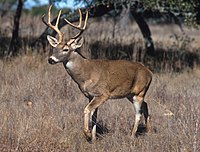
Photo from wikipedia
Abstract The lack of long term independent historical data constitute a major impediment to the further improvement and validation of forest simulation models. In this study, we evaluate the degree… Click to show full abstract
Abstract The lack of long term independent historical data constitute a major impediment to the further improvement and validation of forest simulation models. In this study, we evaluate the degree to which the gap model ZELIG-CFS realistically predicts the long term stand development of mixed forests in southeastern Quebec when disturbance history is considered. An early 1930 forest inventory and disturbance data were used to evaluate model simulation performance over the 1930–2013 period. ZELIG-CFS well predicted the basal area of balsam fir in simulations with and without disturbances. When disturbances were simulated, the predictions for white spruce and white birch were more realistic than in the simulation without disturbances. At the same time, deciduous species that contributed the most to the compositional changes observed during the 20th century in mixed forests (red maple, sugar maple, and trembling aspen) were systematically underestimated by the model. Several improvement avenues are suggested: (1) A better integration of regeneration strategies of tree species, especially the integration of a probability of vegetative reproduction for sprouting species like red maple, sugar maple, trembling aspen and northern white cedar, (2) Coupling gap models with a stand risk model to better simulate natural and human disturbance probability as a source of exogenous mortality.
Journal Title: Forest Ecology and Management
Year Published: 2020
Link to full text (if available)
Share on Social Media: Sign Up to like & get
recommendations!